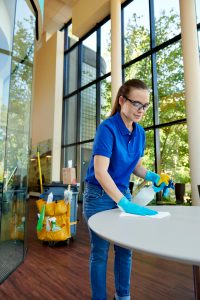Keeping ourselves and others safe and well – the science behind surface wiping
 Current conditions have changed our daily lives in a short period of time. Now more than ever we all want to know that we are doing everything we can to keep ourselves and our colleagues and visitors safe and well. To ensure we can do this requires understanding the science behind surface wiping and cleaning, says Kimberly-Clark Professional.
Current conditions have changed our daily lives in a short period of time. Now more than ever we all want to know that we are doing everything we can to keep ourselves and our colleagues and visitors safe and well. To ensure we can do this requires understanding the science behind surface wiping and cleaning, says Kimberly-Clark Professional.
We want to know that the people we are in contact with have washed their hands properly and that the places we go are as clean and as hygienic as possible. For example: Are our schools and universities clean? Will office workers clean their work surfaces properly to avoid spreading germs? How hygienic are the surfaces in our hospitals? How many germs are found on shopping trolley handles?
Creating a more hygienic workplace, healthcare facility and place to shop and eat does not stop at the washroom. The Centers for Disease Control & Prevention (CDC) recommends prioritising the daily cleaning and disinfecting of hot spots in facilities from offices, to schools, hospitals, shops, and places to eat.
“Objects that are touched by lots of people throughout the day such as door handles, elevator buttons and shopping trolleys should be cleaned and disinfected frequently in order to break the chain of germ transmission. Many of our customers are needing to think in a different way about what, how and how often they clean, to keep people safe,” says Steve Jones, General Manager (UK and Ireland), Kimberly-Clark Professional. “Understanding the difference between cleaning and disinfecting enables facilities to manage hygiene more effectively and prioritise frequently touched surfaces.”
Cleaning vs. Disinfecting
Cleaning removes germs, dirt, and other impurities from surfaces or objects by using detergent (or soap and water) to physically remove germs from surfaces. This process does not necessarily kill germs, but by removing them, it lowers their numbers and the risk of spreading infection.
Disinfecting kills germs on surfaces or objects by using chemicals1. This process does not necessarily clean dirty surfaces or remove germs, but by killing germs on a surface after cleaning, it can further lower the risk of spreading infection.
The CDC recommends a two-step daily routine to clean frequently touched surfaces. For Step 1 clean surface with a detergent or soap and water. With Step 2 disinfect the surface using an EN-registered disinfectant. The CDC guidelines also recommend providing disposable wipes so that commonly used surfaces can be wiped down before each use2. Surfaces considered hot spots for germs also include computer keyboards, phones and light switches. Science indicates why these surfaces need daily hygiene protocols in addition to hand hygiene standards in facilities.
The average desk has 400 times more bacteria than a toilet seat3, a keyboard harbours 8,900 bacteria4 and a mobile phone harbours 6,300 bacteria5. In healthcare facilities 67% of soap buckets tested harboured bacteria6, with 93% of cleaning towels sampled containing live bacteria7.
A study by Dr. Charles Gerba on shopping trollies found E.coli on almost half of those tested. These germs may be transferred from the trolley to hands, to food and the face8. With adults touching 7,200 surfaces9 and touching their face 552 times in the span of 24 hours10, then we can see why that in today’s current conditions tougher hygiene protocols are required. While placing hand sanitiser and signage in offices and common areas is a step in the right direction, studies show it simply is not enough to make a real impact.
No matter which surface areas they come into contact with throughout the day, give your employees, visitors, patients and customers greater peace of mind by providing proven cleaning and disinfecting solutions to help break the chain of germ transmission. In the midst of change, creating exceptional workplaces includes doing everything you can to ensure that we all use proper hand hygiene protocols and that shared surfaces are clean and hygienic.
For more information about how to make your facility truly exceptional – a place where everyone feels equipped and empowered to contribute to a more hygienic environment – visit our hand and surface cleaning page.
Website: www.kcprofessional.co.ukhttps://www.kcprofessional.co.uk/
Tel: 0870 155 1044
-ends-
To have your industry news published in the pages of FMJ’s news section, Month in FM, and here online on fmj.co.uk, please send your news and image to Danny Grange danny.grange@kpmmedia.co.uk
The view or information contained within these unedited press releases, are that of the company producing it and not necessary the views of kpm.




